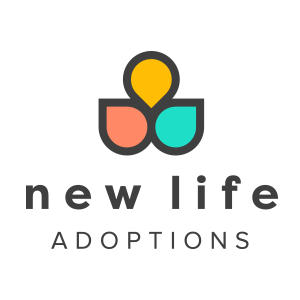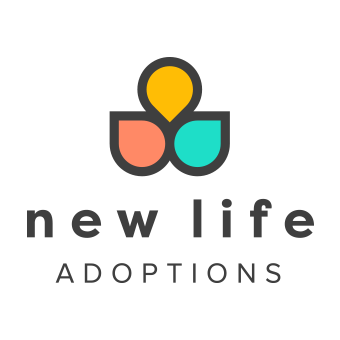If you think about all of your extended relatives, you begin to see how varied and unique these relationships are. It’s the same for birth parents and adoptive families. In adoption, there is a also a deep connection between adoptive families and birth families because of their roots. This is the extended family of adoption. And just like in any other family, the extended family of adoption can look different in each situation.
A Supporting Role
When a birth parent decides to place a child for adoption, there may be other relatives or friends who are supporting and walking alongside them on their adoption journey. When this child, whom they all have grown to love, is placed for adoption, it is a loss for these support people as well as for the birth parents.
Leah, the birth grandmother of a child placed through New Life shares about her role in her daughter, Sophrona’s, adoption journey, “I saw my role as a support role. She needed to make the decisions and I wanted to be available to her for advice and comfort. I really tried not to sway her throughout the process, but to trust in the Lord’s sovereignty. I went with her to a couple of appointments both at New Life and her OB as a way to actively support her and understand from “the experts” what to expect and what she might need, when she could not express or understand yet herself.”
The Extended Family of Adoption
Just as birth parents can have ongoing openness with the adoptive family and child, sometimes birth grandparents, aunts, uncles or close friends of the birth parents can be involved in openness. This extended family of adoption gives the birth relative or friend of the birth family the opportunity to be part of the child’s life, and it also allows more people to love and support the child and his or her family. This openness may include attending a visit with the birth parents, cheering the child on at a sporting event, or sending the child a letter or text message. For the adopted child, this ultimately means more connection to their roots AND more people who love them and support them throughout their life.
Making a Plan
As an adoption agency, we encourage adoptive families to have a discussion with the birth mother and birth father so they know who the birth parents would like to include in their extended family of adoption. The birth parents should always have a say in who else gets to be part of their openness and how that will look. Sometimes, this involves others having direct contact with the adoptive family, and other times these support people receive updates through the birth parents.
Every situation is unique. To give one example of what an extended family of adoption can look like we asked a birth mom, birth aunt, and birth grandma to share about their open adoption experience.
Sophrona, Birth Mother
Q: Did you hope or expect your family to be involved in the openness with your son? How has this worked out either similar or different than you had hoped?
A: “I had always expected my family to be a part of my openness with Samuel. They were supportive from day one, so I was excited to have them be a supportive part of Samuel’s life as he grew up as well.”
Q: What does it mean to you that your son has a relationship with your parents and siblings?
A: “I think it’s amazing that Samuel can have a relationship that grows into what is best for him! It gives him opportunities to learn where he comes from, and to have so many more people in his corner.”
Q: Are there any other thoughts you would like to share or advice that you have for others who are considering open adoption?
A: “What openness looks like has changed throughout the last two and a half years for me. It’s not a bad thing, it’s just a part of changes in my life, my family’s lives, and Samuel’s family. I love that I am connected to Samuel and his family no matter what is going on with our everyday lives and it doesn’t matter how often I see or speak with them; every time is an amazing gift.”
Marissa, Birth Aunt
Q: During Sophrona’s pregnancy, what were your thoughts about her pregnancy and adoption plan?
A: “I was initially shocked about her pregnancy, but at the end of the day came to terms with it. I was hopeful she would choose adoption, and when she did I was proud of her and supported her.”
Q: What does your role in Samuel’s life look like now? Do you see him? If so, how often and what does this time look like?
A: “I am Samuel’s “auntie Riss” and love anytime I get to see him! When I’m in the same state, I probably see him once every other month, but it depends. The time I do see him is full of play time and just hanging out with him and his brother Isaac, who I also consider a nephew.”
Q: What does it mean to you to be part of Samuel’s life?
A: “It means that he knows who I am, and when he grows up, I can still have a relationship with him. I love that I see and get to have a connection with my first nephew!”
Leah, Birth Grandmother
Q: What does your role in Samuel’s life look like now? Do you see him? If so, how often and what does this time look like?
A: “We have since moved across the country, but keep in regular contact. Our story is unique in that our best friends adopted Samuel. Before we moved we saw them at church weekly and outside of church maybe once a month. Since moving, his family came and spent a week with us in February. Pictures are shared occasionally as well.”
Q: What does it mean to you to be part of Samuel’s life?
A: “It means the world to see him be loved and reared in a Christian home. I feel so lucky to know him and see his little quirks that are definitely from his birth mom, but to see how he is a part of his adopted family. They comfort him and care for him. They know how to soothe him and what his weaknesses are. It’s really the absolute best scenario I could have ever imagined.”
Q: Are there any other thoughts you would like to share or advice that you have for others who are considering open adoption?
A: “It’s hard. Feelings get hurt, and it can be tough to navigate. We decided after some time of not knowing and speculating how his family was feeling/processing/wanting us to be involved that we would just be as honest as we could, overshare our intentions, and learn to ask questions. Our family had to be sure to take a step back, since we were good friends with them, and allow them to become their own family unit. As time went on we were able to be present more naturally and involved. Again, I couldn’t have dreamt up a more perfect scenario. I am so grateful to be part of this beautiful process.”




